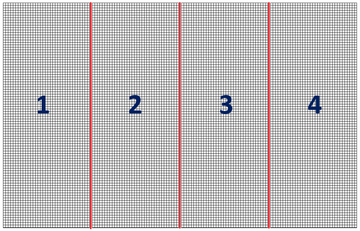Difference between revisions of "HPC Introduction"
Stephen.kime (talk | contribs) |
Stephen.kime (talk | contribs) |
||
| Line 20: | Line 20: | ||
So what does this mean for modellers? By providing the ability to run models on Graphics Cards or across multiple CPU cores, we can achieve significantly shorter model run times, increasing our modelling capabilities to be able to run continuous hydraulic models, with increased cell resolution, across larger extents and more scenarios (Monte Carlo, rainfall ensembles). If you would like to learn more about HPC’s run times and modelling benefits then please refer to our <font color="blue"><tt>Hardware Benchmarking Wiki Page</tt></font>. <br> | So what does this mean for modellers? By providing the ability to run models on Graphics Cards or across multiple CPU cores, we can achieve significantly shorter model run times, increasing our modelling capabilities to be able to run continuous hydraulic models, with increased cell resolution, across larger extents and more scenarios (Monte Carlo, rainfall ensembles). If you would like to learn more about HPC’s run times and modelling benefits then please refer to our <font color="blue"><tt>Hardware Benchmarking Wiki Page</tt></font>. <br> | ||
| − | ∗ Cuda Cores are patented to Nvidia graphics cards. This means that TUFLOW is limited to running on CUDA enabled graphics cards only. | + | ∗ Cuda Cores are patented to Nvidia graphics cards. This means that TUFLOW is limited to running on CUDA enabled graphics cards only.<br> |
| + | <br> | ||
| + | '''<u>Further Support</u>'''<br> | ||
| + | If you experience an issue that is not detailed above or in one of our other [[HPC Best Practice Modelling Guidance|HPC Modelling Guidance Pages]] please a send an email to support@tuflow.com | ||
Revision as of 15:05, 15 March 2018
As of TUFLOW build 2017-09-AA, TUFLOW offers HPC (Heavily Parallelised Compute) as an alternate 2D Shallow Water Equation (SWE) solver to TUFLOW Classic. Whereas TUFLOW Classic is limited to running a simulation on a single CPU core, HPC provides parallelisation of the TUFLOW model allowing modellers to run a single TUFLOW model across multiple CPU cores or GPU graphics cards which utilise thousands of smaller CUDA* cores. This is shown to provide significantly quicker model run times for TUFLOW users.
Solution Scheme and Parallelisation
TUFLOW HPC is an explicit finite volume solution which differs to TUFLOW Classic which is an implicit finite difference equation. Time derivatives of cell averaged water depth, u-velocity and v-velocity are computed on a cell-by-cell basis and the model evolved using an explicit ODE solver. Calculation of the cell based derivatives are highly independent of each other making it possible to run this solution scheme across multiple processors or GPU cards. Parallelisation is done by breaking up the model into vertical ribbons. Each ribbon of the model is run on a different processor (or GPU card) with boundary information shared between processors at each timestep as illustrated in the image below.
Mass Conservation and Timestep
The explicit finite volume solution scheme utilised in HPC is mass conserving by construction. This differs to TUFLOW Classic, which can continue to simulate a model with some volume error due to it being an implicit finite difference scheme. The stability of the explicit finite volume scheme used in TUFLOW HPC is linked to the time step, flow velocities, water depth, and eddy viscosity. The maximum timestep that can be used while maintaining model stability changes as the model evolves. While it is possible to choose a fixed timestep ahead of time (similarly to TUFLOW Classic) that will guarantee model stability from start to finish, shorter run times may be achieved through the use of adaptive time stepping where the solver continually modifies the timestep based on various stability criteria. This is explained in more detail in our HPC Adaptive Timestep Wiki Page.
Cell Discretisation
HPC cell discretisation is the same as in TUFLOW Classic, where the v velocities are defined on the horizontal mid-points between cell centres and the u-velocities on the vertical mid-points. This has removed the “checkerboarding effect” observed at times in previous TUFLOW GPU result outputs.
Benefits of HPC
In general most of the functionality and features of TUFLOW Classic are available in HPC, with more of these features becoming available to HPC in due time. To find out more about what TUFLOW Classic features aren’t included in the latest TUFLOW HPC build you can reference the HPC Features Wiki Page or the TUFLOW 2017-09 Release Notes.
So what does this mean for modellers? By providing the ability to run models on Graphics Cards or across multiple CPU cores, we can achieve significantly shorter model run times, increasing our modelling capabilities to be able to run continuous hydraulic models, with increased cell resolution, across larger extents and more scenarios (Monte Carlo, rainfall ensembles). If you would like to learn more about HPC’s run times and modelling benefits then please refer to our Hardware Benchmarking Wiki Page.
∗ Cuda Cores are patented to Nvidia graphics cards. This means that TUFLOW is limited to running on CUDA enabled graphics cards only.
Further Support
If you experience an issue that is not detailed above or in one of our other HPC Modelling Guidance Pages please a send an email to support@tuflow.com
